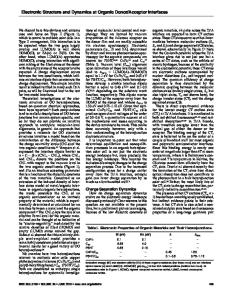Electronic Structure at Tetratetracontane/Au(111) Interface
- PDF / 1,631,608 Bytes
- 5 Pages / 612 x 792 pts (letter) Page_size
- 69 Downloads / 364 Views
1029-F04-09
Electronic Structure at Tetratetracontane/Au(111) Interface Kaname Kanai, Yukio Ouchi, and Kazuhiko Seki Nagoya University, Nagoya, 464-8602, Japan ABSTRACT Modification of the quasi two-dimensional surface state on Au(111) surface with adsorption of n-alkane molecule, tetratetracontane: TTC was investigated by angle-resolved photoemission spectroscopy (ARUPS) and X-ray photoemission spectroscopy (XPS). From ARUPS the energy band structure of the surface state of Au(111) surface is found to be significantly affected by TTC adsorption. The modified surface potential on Au(111) surface by the adsorption confines the surface electrons into the quantum well newly established between TTC wide energy gap and sp band gap of the Au(111) surface increasing its localization nature. Clear chemical shift in C 1s core level was observed in XPS spectrum for TTC layer right at the interface and small back-donation from Au(111) surface to TTC unoccupied states is suspected. On the other hand, a large interface dipole layer about 0.72 eV was observed by TTC adsorption. From these results, Pauli repulsion effect is expected not to have dominant effect on such large dipole formation on TTC adsorption. INTRODUCTION Long chain n-alkanes are basic type of organic compounds and have been studied by various experimental methods for a long time. Seki and his coworkers have studied the electronic structure of teteratetracontane (TTC: C44H90), the model molecule of polyethylene, adsorbed on single crystal and polycrystalline metal surfaces using metastable atom electron spectroscopy and ultraviolet photoemission spectroscopy (UPS) [1-4]. Ishii et al. studied the TTC film on Au(111) surface by combining ARUPS and the theoretical simulation of the ARUPS spectra and the orientation of TTC molecule was determined [1]. They also reported large dipole formation, about 0.7 eV even in such physisorbed system and suggested that which can be explained by the polarization of the TTC molecule due to an image force. On the other hand, the direct information has been lacking in the modification of the Au(111) surface state due to interaction between TTC and surface electrons. In this work, we found that Au(111) Shockley surface state is significantly modified by TTC adsorption showing the enhancement of effective mass, m* in contrast to the rare-gas physisorption, which is well-known ideal physisorption system. Moreover C 1s core level shift observed only right at the interface indicates that small backdonation from Au to TTC unoccupied states. These results provide the insight into the origin of the interface dipole formation for the physisorption of the organic molecule on metal surface. EXPERIMENT The ARUPS and XPS were performed in the ultrahigh vacuum chambers whose base pressure is less than 2 10-9 Pa. It consists of a main chamber equipped with a high-resolution hemispherical electron energy analyzer Omicron EA-125 HR, Helium discharge lamp and monochromatic X-ray source (Al α, hν = 1,486.6 eV) and low energy electron diffraction (LEED)
Data Loading...











